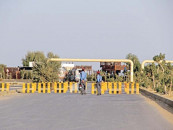K-P health dept uses tech to solve supply woes
Introducing public health forecasting and supply chain strategy

Introducing public health forecasting and supply chain strategy. PHOTO: FILE
As simple as the programme sounds, it has a few tricks up its sleeves, particularly an automated ‘forecasting’ system which can forewarn officials about an impending shortage of health commodities at government-run centres across the province.
Moreover, the strategy hopes to eliminate the need for a storekeeper or a doctor knocking on the doors of storage facilities in the provincial capital asking for health commodities. The solution is a bit of software which would automatically detect shortage at health facilities and direct the staff concerned to dispatch the required items in time.
According to official documents, a copy of which is available with The Express Tribune, the government plans on introducing a fully integrated, functional, optimised, interlinked, automated and robust public health supply chain system for the province complete with data visibility at each level.
The aim of the software is to make sure that quality products are available at health facilities and ensure there is never a situation where a shortage arises – completing all of these tasks efficiently and in a cost-effective manner.
“With this ultimate goal, this document developed by the health and population welfare departments with technical assistance from USAID aims to outline a five-year strategy for public health supply chain improvement,” the documents read.
Currently, the supply chains for both, the health and population welfare departments are fragmented. As a result not only does it cause duplication of efforts, but also wastage of resources.
“To create an organised body at the provincial level responsible for supply chain functions in an integrated manner, ensuring synergy, efficiency, and inter and intradepartmental coordination is one of the objectives of the programme,” the documents added.
Senior health officials pointed out that the system can help keep health centres fully stocked.
“Let’s make it simple, suppose you need 10 tablets for a month, you hand out five to patients, the software automatically updates it and the store [which is in the loop] dispatches five tablets for your facility automatically even before you call so that you do not fall short,” a senior health official told The Express Tribune.
The documents added that currently, storage facilities at the provincial and district levels are inadequate which lack space and infrastructure to cater to the storage needs as well as volumes of medicines and other medical supplies being procured. By adding inventory management at all levels of the supply chain, the system can be improved.
Owing to this inefficient system, different health programmes in the province maintain their own management information systems, most of which do not cover logistical functions, including forecasting, supply planning, warehousing, and stock requisitioning.
However, these programmes including the lady health worker, mother and child health, expanded programme on immunisation and nutrition programme MIS have limited logistical information which was not sufficient to measure overall supply chain performance.
“The strategy envisages the development of an integrated health information system policy framework, moving towards integration to achieve synergies and data sharing while building governmental capacity in this area,” the document read.
Although the health sector operates quite a few information systems, the current supply chain system lacks means to measure and improve performance, transparency, accountability, and cost-effectiveness.
However, this would require structural changes, the document warned, including infrastructure development, recruitment of trained personnel, and financing as per the suggested model.
Published in The Express Tribune, October 3rd, 2017.


















COMMENTS
Comments are moderated and generally will be posted if they are on-topic and not abusive.
For more information, please see our Comments FAQ